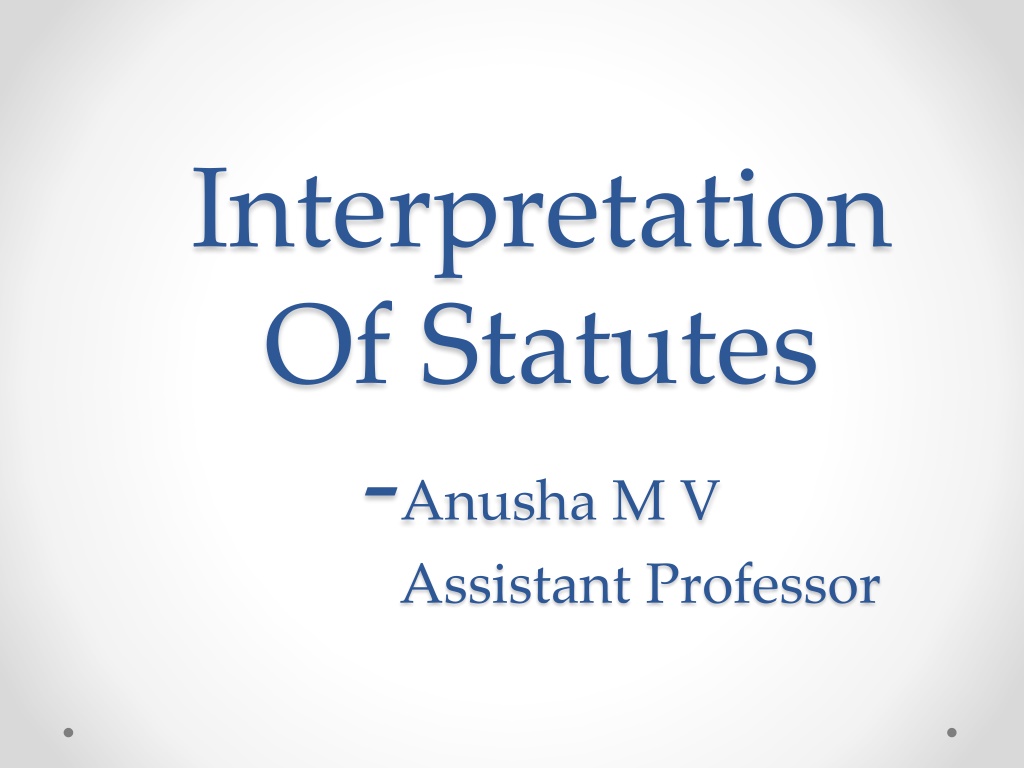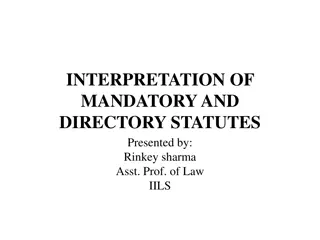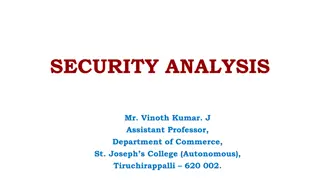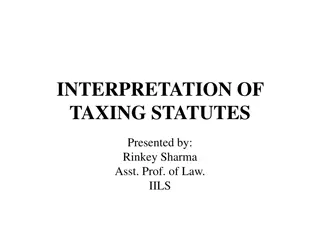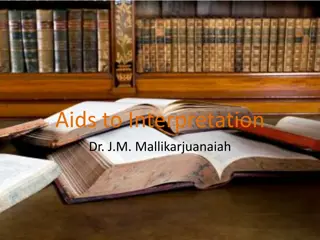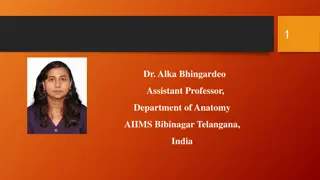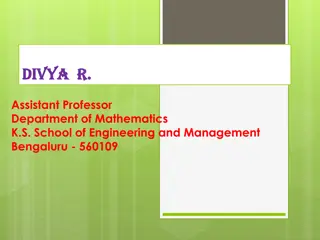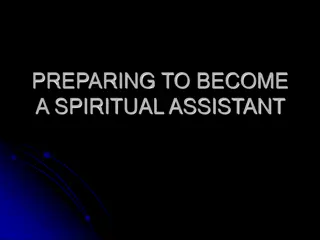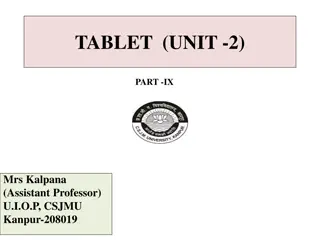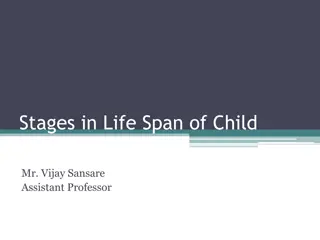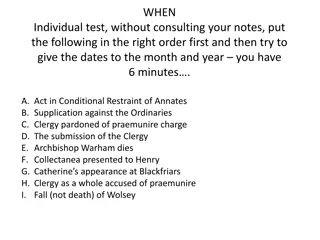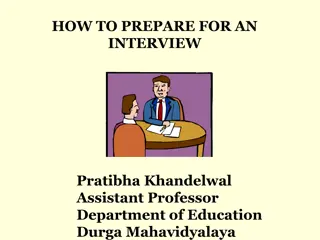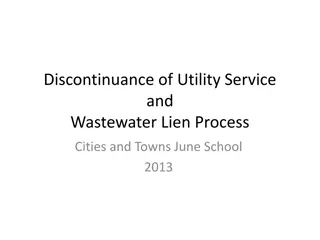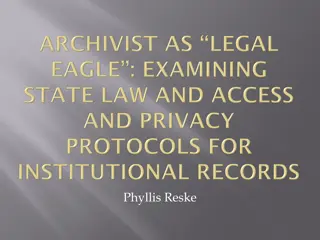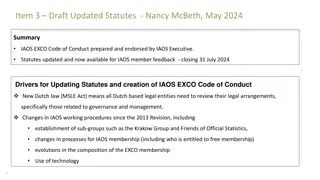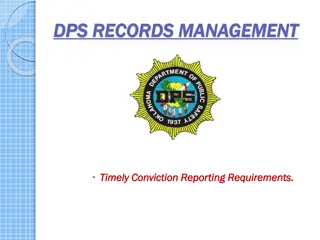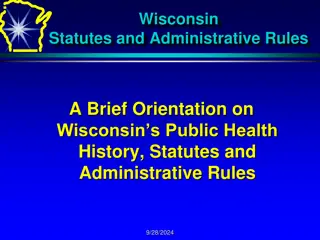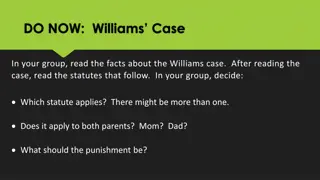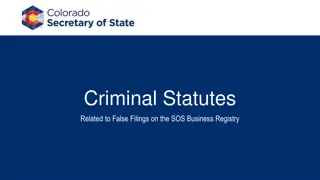Understanding Statutes: An Overview by Anusha M.V., Assistant Professor
This collection of images provides an insightful overview of statutes, covering their definition, creation process, commencement, operation, presumption against retrospective operation, repeal, and consequences of repeal. It explains the key aspects of statutes in a clear and concise manner.
Download Presentation

Please find below an Image/Link to download the presentation.
The content on the website is provided AS IS for your information and personal use only. It may not be sold, licensed, or shared on other websites without obtaining consent from the author. Download presentation by click this link. If you encounter any issues during the download, it is possible that the publisher has removed the file from their server.
E N D
Presentation Transcript
Interpretation Of Statutes -Anusha M V Assistant Professor
LAW Statute Judge-made Law Rule Constitution
What is a Statute? The law that has its source in legislation is called enacted law or statute law. It is the principal source of modern law. Created by legislature. Statute may be regarded as a body of universal, absolute, binding rules. It is the expression of will of legislature.
How does a statute come into existence? Preparation of draft Accumulation of rules in a single document called bill Passing of the bill by legislature Assent by executive head
Commencement and operation of a statute Date of commencement or enforcement can be same. Date of commencement may be postponed a) For entire statute b) For a part of statute; to a date to be notified A statute may operate in whole territory or in parts. A statute may operate prospectively or retrospectively or in both manner.
Presumption against retrospective operation is not applicable to Burden of proof Rule of evidence Procedural Statute Limitation Babulal Amthalal Mehta AIR 1957 SC 877 SS Gadgil v Lal and Co. 1965 AIR 171
Repeal of Statutes Express Repeal: Power to enact carries with it power to repeal Substitution of a provision combines repeal of earlier provision and insertion of new provision Implied Repeal: There is a presumption against implied repeal The presumption is however rebutted and the repeal is inferred where. The provisions of the latter Act are inconsistent with or repugnant to the earlier Act Where the two Acts cannot stand together.
Consequences of repeal A repeal does not invalidate rights, duties, penalties, remedies, proceedings, etc. accrued out of repealed act. In case of repeal of amending act of any central legislation it shall not affect the continuance of any such amendment and in operation at the time of such repeal.
Meaning of Interpretation and construction Interpretation means the art of finding out the true sense of an enactment by giving the words their natural and ordinary meaning whereas Construction means drawing conclusions in the basis of the true spirit of the enactment. (Cooley, Constitutional Limitations, Vol-1) Interpretation is the process to find out the true meaning of the legal provision. Construction is a broad term which envisages interpretation and effects of the interpretation by making subsidiary rules.
Object of interpretation Interpretation is a constitutive feature of legal practice. The primary object of interpretation is to find out the intention of the legislature. It resolves the tension arose due to conflicting understanding of law. To remove ambiguity is one of the important objective of interpretation To develop precedents for future references.
Importance of rules of interpretation To resolve conflicts in the society. To make the meaning of law clear and understandable. to validate or challenge the authority of parliament. To maintain uniformity in application of rules in similar facts.
Rules of Interpretation Primary Rules Literal rule Mischief Rule Golden Rule Harmonious Construction Secondary Rules Noscitur a sociis Ejusdem generis Reddendo singula singulis
LITERAL RULE The first primary rule- litera legis. Verbis legis non est recelendum- there should be no departure from the words of law. Giving words their ordinary and natural meaning is known as literal interpretation. This rule was laid down in Sussex Peerage Case (1884): If the words of the statute are in themselves precise and unambiguous, then no more can be necessary than to expound those words in their natural and ordinary sense. But if any doubt arises from the terms employed by the Legislature, it has always been held a safe mean of collecting the intention to call in aid the ground and cause of making the statute, and to have recourse to the preamble .
The basic rule is to look at the intention of the legislature. According to the proponents of this rule a judge cannot use his own subjectivity to replace legislator s subjectivity. This rule does not allow flexibility and discards any deviation from the legislative intent. Lord Esher in R. v. The Judge of the City of London Court stated that if the words of an Act are clear you must follow them, even though they lead to manifest absurdity The supporters of this rule say that It is the duty of the court not to modify the language of the Act.
Maqbool Hussain v State of Bombay The appellant, a citizen of India, on arrival at an airport did not declare that he brought gold with him. Gold, found in his possession during search in violation of government notification, was confiscated under Sea Customs Act, 1878. He was also charged under Foreign Exchange Regulation Act. The appellant pleaded that his trial under the Act was violative of Art 20(2) of the constitution relating to double jeopardy as he was already punished for his act by was of confiscation of the gold. It was held by the Supreme Court that the sea customs authority is not a court or a judicial tribunal and the confiscation is not a penalty.
Municipal board v State transport authority,Rajasthan According to S. 64 A of the Motor vehicles Act, 1939 an application against the change of location of a bus stand could be made within 30 days of receipt of order of regional transport authority . The application was moved after 30 days on the contention that statute must be read as 30 days from the knowledge of the order The Supreme Court held that literal interpretation must be made and hence rejected the application as invalid.
Madan mohan v K.Chandrashekara when a statute contains strict and stringent provisions, it must be literally and strictly construed to promote the object of the act. Bhavnagar University v Palitana Sugar Mills Pvt Ltd According to the fundamental principles of construction the statute should be read as a whole, then chapter by Chapter, section by section and then word by word.
The critics say that ordinary and natural meaning of the words should not be controlled by spirit of legislature. This rule has been criticised on account of : It being too rigid. This rule fails to recognize error on part of legislature. The natural and ordinary meaning of a word may get in conflict with the purpose of the law.
Exact Meaning should be preferred to loose meaning Prithipal Singh v. UOI (1982)- There is a presumption that words are used in an Act of Parliament correctly and exactly and not loosely or inexactly. Spillers ltd. v. Caradix Assessment Committee and Pritchard (1931)- exact meaning of the word contiguous touching was preferred over its loose meaning neighbouring .
Technical words to be used in Technical Sense If the Act is passed with reference to a particular trade, business or transaction and the words are used which everybody conversant with trade, business or transaction knows or understands to have a particular meaning in it, then the words are to be construed as having that particular meaning - Lord Esher in Unwin v. Hanson (1891). Aswini Kumar Ghose v. Arabinda Ghose (1952) Labour Inspector, Central v. Chittapur Stone Quarrying Co. Pvt. Ltd. (1972)
Cassus omissus It means cases omitted. a matter which should have been, but has not been provided for in a statute cannot be supplied by courts, as to do so will be legislation and not construction. - Hansraj Gupta v. Dehra Dun Mussorie Electric Tramway Co. Ltd. If the legislature has omitted to provide for in a statute, the court cannot fill the gap by means of adding or substituting.
State of Jharkhand v. Govind Singh Section 53(3) and 68 of Forest Act, 1927 provided for confiscation of vehicle used in a forest offence. Further it provided release of vehicle only when offence is compounded and compensation money and full value of the vehicle is paid . It did not provided for release of vehicle on payment of fine which was alleged by accused. The court held that since the legislature has omitted to provide for the same it is not possible to read a power to levy fine in lieu of confiscation and release the vehicle.
Cassus omissus creates a lot of difficulties while applying a provision of law especially when one is related to another and legislature fails to amend the latter. An example of such difficulty is Amendment S. 25of CPC in 1976. it provided for transfer of cases from a High court or Civil court in one state to those located in another state. But a related provision S. 23 was not changed. It provided Where Several courts having jurisdiction are subordinate to different High Courts, the application of transfer shall be made to the High Court within local limits of jurisdiction the court of first instance is situated.
Construction ut res magis valeat quam pereat It is better for a thing to have effect than to be made void. The Courts strongly lean against a construction which reduces the statute to a futility. presumption in favour of constitutionality of Statute.
Viscount Simon, L.C. in Nokes v. Doncaster Amalgamated Collieries Ltd. We should avoid a construction which would reduce the legislation to futility or the narrower one which would fail to achieve the manifest purpose of the legislation. We should rather accept the bolder construction based on the view that Parliament would legislate only for the purpose of bringing about an effective result. Thus, if the language is capable of more than one interpretation, one ought to discard the literal or natural meaning if it leads to an unreasonable result, and adopt that interpretation which leads to reasonably practical results.
Avtar Singh vs State of Punjab (1955) Appellant was convicted of theft of electricity under Section 39 of Electricity Act, 1990. He contented that the proceeding were illegal because they were not initiated by any of the persons as mandated by Section 50 of the act. It was held that under this principle, the requirement of Section 50 should be given effect.
Corporation of Calcutta vs Liberty Cinema (1965) Under a. 413 of the Calcutta Municipal Act, 1951, no person shall without a license granted by the Corporation of Calcutta, keep open any cinema house for public amusement in Calcutta. Under s. 548(2), for every license under the Act, a fee may be charged at such rate as may from time to time be fixed by the Corporation. In 1948, the appellant (Corporation) fixed fees on the basis of annual valuation of the cinema house. The respondent, who was the owner and licensee of a cinema theater, had been paying a license fee of Rs. 400 per year on that basis. In 1958, the appellant, by a Resolution, changed the basis of assessment of the fee.
Under the new method the fee was to be assessed at rates prescribed per show according to the sanctioned seating capacity of the cinema house; and the respondent had to pay a fee of Rs. 6,000 per year. The respondent, therefore moved the High Court for the issue of a writ quashing the resolution and the application was allowed. In the appeal to the Supreme Court the appellant contended that (i) the levy was a tax and not a fee in return for services and (ii) s. 548(2) does not suffer from the vice of excessive delegation; While the respondent contended that (i) the levy was a fee in return for services to be rendered and not a tax, and as it was not commensurate with the costs incurred by the Corporation in providing the services, the levy was invalid; (ii) if s. 548 authorized the levy of a tax, as distinct from a fee in return for service rendered, it was invalid, as it amounted to an illegal delegation of legislative functions to the appellant to fix the amount of a tax without any guidance for the purpose and (iii) the levy was invalid as violating Art. 19(1) (f) and (g) of the Constitute.
HELD (per Sarkar, Raghubar Dayal and Mudholkar JJ) : (i) The levy was not a fee but a tax. The word "fee" in s. 548 must be read as referring to a tax as any other reading would make the section invalid, and in interpreting a statute, it ought to be made valid if possible.
GOLDEN RULE The rule propounded by Lord Wensleydale in Grey v Pearson (1857). The grammatical and ordinary sense of the words is to be adhered to unless that would lead to some absurdity or some repugnance or inconsistency with the rest of the instrument in which case the grammatical and ordinary sense of the words may be modified so as to avoid the absurdity and inconsistency, but no farther. This rule allows deviation from the literal rule and even disregards intention of legislature in some instances.
It allows to adhere to the ordinary meaning of the words used, and to the grammatical construction. The original meaning needs to be modified only in case the literal interpretation leads to any manifest absurdity or repugnance. Tirath Singh v. Bachittar Singh (1955) Where the language of a statute, in its ordinary meaning and grammatical construction leads to a manifest contradiction of the apparent purpose of the enactment, or to some inconvenience or absurdity, hardship or injustice, presumably not intended, a construction may be put upon it which modifies the meaning of the words, and even the structure of the sentence.
Lee v. Knapp (1967) The interpretation of the word "stop" was involved. Under Road Traffic Act, 1960, a person causing an accident "shall stop" after the accident. In this case, the driver stopped after causing the accident and then drove off. It was held that the literal interpretation of the word stop is absurd and that the requirement under the act was not fulfilled because the driver did not stop for a reasonable time so that interested parties can make inquiries from him about the accident.
Uttar Pradesh Bhoodan Yagna Samiti v. Brij Kishore (1988) the Supreme Court held that the expression landless person used in section 14 of U.P. Bhoodan Yagna Act, 1953 which made provision for grant of land to landless persons, was limited to landless laborers . A landless labour is he who is engaged in agriculture but having no agricultural land. The Court further said that any landless person did not include a landless businessman residing in a city. The object of the Act was to implement the Bhoodan movement, which aimed at distribution of land to landless labourers who were verged in agriculture. A businessman, though landless cannot claim the benefit of the Act.
Ramji Missar v. State of Bihar (1962) in construing section 6 of the Probation of Offenders Act, 1958, the Supreme Court laid down that the crucial date on which the age of the offender had to be determined is not the date of offence, but the date on which the sentence is pronounced by the trial court An accused who on the date of offence was below 21 years of age but on the date on which the judgment pronounced, if he was above 21 years, he is not entitled to the benefit of the statute. This conclusion reached having regard to the object of the Act. The object of the Statute is to prevent the turning of the youthful offenders into criminals by their association with the hardened criminals of mature age within the walls of the prison. An accused below 21 years is entitled to the benefit of the Act by sending him under the supervision of the probation officer instead of jail.
Advantages This rule prevents absurd results in some cases containing situations that are completely unimagined by the law makers. It focuses on imparting justice instead of blindly enforcing the law. Disadvantages The golden rule provides no clear means to test the existence or extent of an absurdity. It seems to depend on the result of each individual case. Whilst the golden rule has the advantage of avoiding absurdities, it therefore has the disadvantage that no test exists to determine what is an absurdity. This rule tends to let the judiciary overpower the legislature by applying its own standards of what is absurd and what it not.
Mischief Rule One of the oldest rules of interpretation aimed at purposive interpretation. This rule gives judges the most discretion of all the rules. It is often referred to as the rule in Heydon s Case . It was reported by Lord Coke and decided by the Barons of the Exchequer in Heydon s Case (1584). It is used when words of a statute are capable of bearing more than meanings.
That for the sure and true interpretation of all statutes in general, be they penal or beneficial, restrictive or enlarging of the common law; four things are to be considered What was the common law before the passing of the Act? What was the mischief and defect for which the common law did not provide? What remedy the Parliament hath resolved and appointed to cure the disease of the Commonwealth ? The true reasons for the remedy? And then the office of all the Judges is always to make such construction as shall suppress the mischief and advance the remedy.
The rule itself has went through stages of interpretation. The words used in the judgment itself creates some ambiguity. The traditional use of mischief rule suggests a wider interpretation of the rule even going beyond the intention of legislature. The modern use of the rule is rather narrower whereby judges limit themselves to the legislative intent.
Lord Reid in Black-Clawson International Ltd. v. Papierwerke Waldhof Ascheffenburg (1975) explained the meaning of word mischief. the word mischief is traditional . He expanded it to include the facts presumed to be known to Parliament when the Bill which became the Act in question was before it and the unsatisfactory state of affairs disclosed by these facts which Parliament can properly be supposed to have intended to remedy by the Act .
Lord Roskill in Anderton v. Ryan (1985) Statutes should be given what has become known as a purposive construction, that is to say that the courts should identify the mischief which existed before passing of the statute and then if more than one construction is possible, favour that which will eliminate the mischief so identified. Lord Griffith in Pepper v. Hart (1993) The courts now adopt a purposive approach which seeks to give effect to the true purpose of legislation and are prepared to look at much extraneous material that bears on the background against which the legislation was enacted.
New India Assurance Co. Ltd. v. Nusli Nerille Wadia (2008), Sinha J.- To interpret a statute in a reasonable manner the court must place itself in the chair of a reasonable legislator/author. Two elements of objectivity in the process of construction: first the interpreter should assume that the legislature is composed of reasonable people seeking to achieve reasonable goals in a reasonable manner; and second the interpreter should accept the non rebuttable presumption that members of the legislative body sought to fulfill their constitutional duties in good faith. This formulation allows the interpreter to inquire not into the subjective intent of the author, but rather the intent the author would have had, had he or she acted reasonably.
The Supreme Court in Sodra Devis case (1957) expressed the view that the rule in Heydon s case is applicable: oOnly when the words in question are ambiguous oAnd are reasonably capable of more than one meaning. In the case of Kanailal Sur v. Paramnidhi Sadhukhan Gajendragadkar J., stated that the recourse to object and policy of the Act or consideration of the mischief and defect which the Act purports to remedy is only permissible when the language is capable of two constructions.
Elliot v Grey (1960) The defendant s car was parked on the road. It was jacked up and had its battery removed. He was charged with an offence under the Road Traffic Act 1930 of using an uninsured vehicle on the road. The defendant argued he was not using the car on the road as clearly it was not driveable. It was held: The court applied the mischief rule and held that the car was being used on the road as it represented a hazard and therefore insurance would be required in the event of an incident. The statute was aimed at ensuring people were compensated when injured due to the hazards created by others.
Bengal Immunity Co. v. State of Bihar (1955) Supreme Court applied the rule in construction of Art. 286 of the Constitution of India. After referring to the state of law prevailing in the provinces prior to the Constitution as also to the chaos and confusion that was brought about in inter-State trade and commerce by indiscriminate exercise of taxing powers by the different provincial Legislatures founded on the theory of territorial nexus S.R. Das, C.J.I., proceeded to say: It was to cure this mischief of multiple taxation and to preserve the free flow of inter-State trade or commerce in the Union of India regarded as one economic unit without any provincial barrier that the Constitution-Makers adopted Art. 286 in the Constitution.
RMD Chamarbaugwalla v. Union of India (1957) Construction of section 2(d) of the Prize Competitions Act was involved. Prize Competition means any competition in which prizes are offered for the solution of any puzzle based upon the building up arrangement, combination or permutation of letters, words or figures . The question was whether in view of this definition, the Act applies to competitions which involve substantial skill and are not in the nature of gambling. The Supreme Court, after referring to the previous state of the law, to the mischief that continued under that law and to the resolutions of various States under Art. 252(1) authorizing Parliament to pass the Act stated: Having regard to the history of the legislation, the declared object thereof and the wording of the statute, we are of opinion that the competitions which are sought to be controlled and regulated by the Act are only those competitions in which success does not depend on any substantial degree of skill
Advantages It gives effect to parliament's intentions It allows judges to use their common sense and save parliament time It allows judges to consider social and technological changes It allows judges to look at external aids. Disadvantages Finding the intention of parliament can be difficult It is reasonable to argue that what parliament intended can only be seen in what it actually wrote in the act It is undemocratic It might cause uncertainty if a judge changes the meaning of statute
Rule of Harmonious Construction Statute must be read as a whole A statute should be read as a whole and one provision of the Act should be construed with reference to other provisions in the same Act This will make a consistent enactment of the whole statute. This will reduce any inconsistency or repugnancy either within a section or between a section and other parts of the statute.
According to rule of harmonious construction the court, while interpreting, must try to avoid a conflict between the provisions of Statute. In a situation of apparent conflict, the courts must make attempt at reconciliation between the provisions in conflict to give effect to both, i.e., creating harmony between them. It runs on the premise that Parliament did not make the provisions in a an enactment to defeat each other or to make one of them ineffective by giving only effect to the other/s.
CIT v Hindustan Bulk Carriers (2003) The courts must avoid a head on clash of seemingly contradicting provisions and they must construe the contradictory provisions so as to harmonize them. The provision of one section cannot be used to defeat the provision contained in another unless the court, despite all its effort, is unable to find a way to reconcile their differences. When it is impossible to completely reconcile the differences in contradictory provisions, the courts must interpret them in such as way so that effect is given to both the provisions as much as possible. Courts must also keep in mind that interpretation that reduces one provision to a useless number or dead is not harmonious construction. To harmonize is not to destroy any statutory provision or to render it fruitless.
Sirsilk Ltd. v. Govt. of Andhra Pradesh (1964) Certain disputes between the employer and the workmen adjudicated by an industrial tribunal and sent for publication to Government. However, before the award was published, the parties came to a settlement and wrote a letter to the government intimating their settlement, with the request that award shall not be published. Government refused to do so. Matter went till Supreme court- decided in favour of petitioners. The apparent conflict was between section 17 and 18 of the Industrial Disputes Act,1947.
